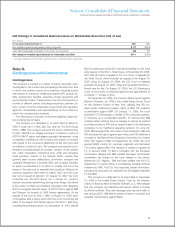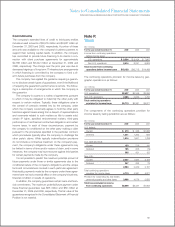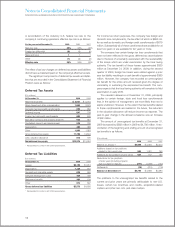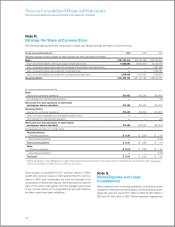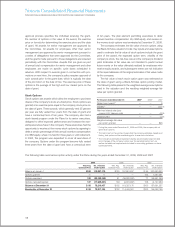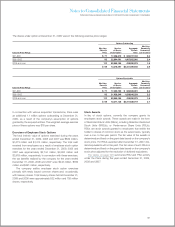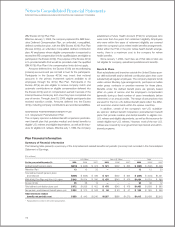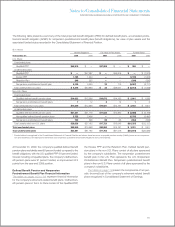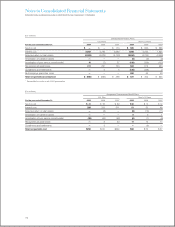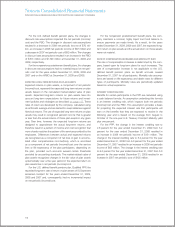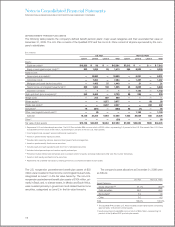IBM 2009 Annual Report Download - page 111
Download and view the complete annual report
Please find page 111 of the 2009 IBM annual report below. You can navigate through the pages in the report by either clicking on the pages listed below, or by using the keyword search tool below to find specific information within the annual report.
Notes to Consolidated Financial Statements
INTERNATIONAL BUSINESS MACHINES CORPORATION AND SUBSIDIARY COMPANIES
Employees purchased 3.2 million, 3.5 million and 4.0 million
shares under the ESPP during the years ended December 31,
2009, 2008 and 2007, respectively. Cash dividends declared
and paid by the company on its common stock also include
cash dividends on the company stock purchased through the
ESPP. Dividends are paid on full and fractional shares and can
be reinvested in the ESPP. The company stock purchased
through the ESPP is considered outstanding and is included in
the weighted-average outstanding shares for purposes of com-
puting basic and diluted earnings per share.
Approximately 9.6 million, 12.8 million and 16.3 million shares
were available for purchase under the ESPP at December 31,
2009, 2008 and 2007, respectively.
Note U.
Retirement-Related Benets
Description of Plans
IBM sponsors defined benefit pension plans and defined con-
tribution plans that cover substantially all regular employees, a
supplemental retention plan that covers certain U.S. executives
and nonpension postretirement benefit plans primarily consist-
ing of retiree medical and dental benefits for eligible retirees
and dependents.
U.S. Plans
DEFINED BENEFIT PENSION PLANS
IBM Personal Pension Plan
IBM provides U.S. regular, full-time and part-time employees
hired prior to January 1, 2005 with noncontributory defined
benefit pension benefits via the IBM Personal Pension Plan. Prior
to 2008, the IBM Personal Pension Plan consisted of a tax quali-
fied (qualified) plan and a non-tax qualified (nonqualified) plan.
Effective January 1, 2008, the nonqualified plan was renamed
the Excess Personal Pension Plan (Excess PPP) and the quali-
fied plan is now referred to as the Qualified PPP. The combined
plan is now referred to as the PPP. The Qualified PPP is funded
by company contributions to an irrevocable trust fund, which is
held for the sole benefit of participants and beneficiaries. The
Excess PPP, which is unfunded, provides benefits in excess of
IRS limitations for qualified plans.
Benefits provided to the PPP participants are calculated using
benefit formulas that vary based on the participant. Pension
benefits are calculated using one of two methods based upon
specified criteria used to determine each participant’s eligibility.
The first method uses a five-year, final pay formula that deter-
mines benefits based on salary, years of service, mortality and
other participant-specific factors. The second method is a cash
balance formula that calculates benefits using a percentage of
employees’ annual salary, as well as an interest crediting rate.
Benefit accruals under the IBM Personal Pension Plan
ceased December 31, 2007 for all participants.
U.S. Supplemental Executive Retention Plan
The company also sponsors a nonqualified U.S. Supplemental
Exec utive Reten tion Plan (Retention Plan). The Retention Plan,
which is unfunded, provides benefits to eligible U.S. executives
based on average earnings, years of service and age at termina-
tion of employment. Effective July 1, 1999, the company replaced
the then effective Retention Plan with the current Retention
Plan. Some participants in the previous Retention Plan will still
be eligible for benefits under that prior plan if those benefits are
greater than the benefits provided under the current plan.
Benefit accruals under the Retention Plan ceased December
31, 2007 for all participants.
DEFINED CONTRIBUTION PLANS
IBM 401(k) Plus Plan
U.S. regular, full-time and part-time employees are eligible to
participate in the IBM 401(k) Plus Plan, which is a qualified
defined contribution plan under section 401(k) of the Internal
Revenue Code. Effective January 1, 2008, under the IBM 401(k)
Plus Plan, eligible employees receive a dollar-for-dollar match of
their contributions up to 6 percent of eligible compensation for
those hired prior to January 1, 2005, and up to 5 percent of eli-
gible compensation for those hired on or after January 1, 2005.
In addition, eligible employees receive automatic contributions
from the company equal to 1, 2 or 4 percent of eligible com-
pensation based on their eligibility to participate in the PPP as of
December 31, 2007. Employees receive automatic contributions
and matching contributions after the completion of one year of
service. Further, through June 30, 2009, IBM contributed transi-
tion credits to eligible participants’ 401(k) Plus Plan accounts.
The amount of the transition credits was based on a partici-
pant’s age and service as of June 30, 1999.
Prior to January 1, 2008, the company match equaled 50
percent of the first 6 percent of eligible compensation that par-
ticipants contributed to the plan for those hired before January
1, 2005, and 100 percent of the first 6 percent contributed for
those hired after December 31, 2004.
The company’s matching contributions vest immediately and
participants are always fully vested in their own contributions. All
contributions, including the company match, are made in cash
and invested in accordance with participants’ investment elec-
tions. There are no minimum amounts that must be invested
in company stock, and there are no restrictions on transferring
amounts out of company stock to another investment choice,
other than excessive trading rules applicable to such investments.
109


